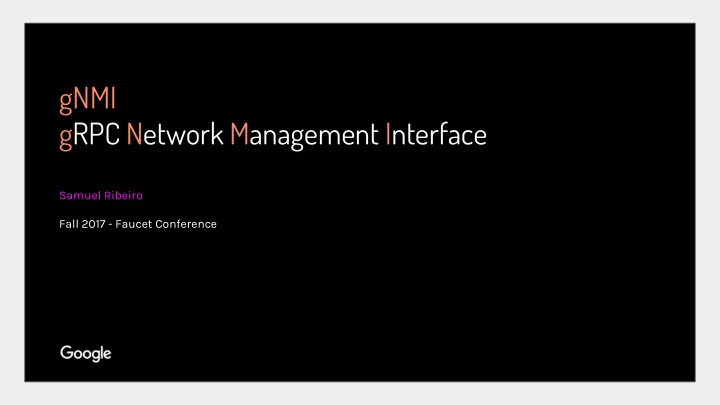

gNMI gRPC Network Management Interface Samuel Ribeiro Fall 2017 - Faucet Conference
Why gNMI? - And what about Openflow? CLI is not Programmable. gNMI vs Openflow lack of transaction management; Openflow -> Forwarding Plane ● ● no structured error handling; Packet A goes to X ● ○ ever changing structure and syntax of gNMI -> Platform ● ● commands; Configuration ○ Hardware/Software ○ Environmental/Power ○
gNMI decomposed gRPC - transport ● high performance RPC framework that can run in any environment ○ gNMI - action ● Get/Set/Subscribe/Capabilities (Service definition with a proto file) ○ Tree-structured data - properties ● OpenConfig - YANG data models ○
gRPC - what is it? Client -----(HTTP/2)----> Server Client calls procedures in Server; ● Uses Protocol Buffers to serialize data; ● (insert TCP port number here) Protocol Buffers - like XML but: ● 3x-10x smaller ○ faster ○ The HTTP/2 session can be: simpler ○ Authenticated ● Encrypted ● www.grpc.io Compressed ● Multiplexing ● Bidirectional ●
gRPC - how is it defined? The set of actions that are allowed between Client and Server is defined by a Service Definition, which is also a Protocol Buffer: service Greeter { rpc SayHello (HelloRequest) returns (HelloReply); rpc ForeverHello ( stream HelloRequest) returns ( stream HelloReply); } C++ message HelloRequest { C# Go string name = 1; Java } Node.js Objective-C message HelloReply { PHP string message = 1; Python } Ruby
gNMI - defined service gNMI { rpc Capabilities (CapabilityRequest) returns (CapabilityResponse); rpc Get (GetRequest) returns (GetResponse); rpc Set (SetRequest) returns (SetResponse); rpc Subscribe ( stream SubscribeRequest) returns ( stream SubscribeResponse); } Server is named Target. ● Target always authenticates Client. Client ---------> Target ● Client always authenticates Target. User Switch ● Session is always encrypted. Collector Server ●
<...> OpenConfig grouping openflow-agent-config { description YANG data models "Openflow agent config"; <...> leaf backoff-interval { YANG ● type uint32; units seconds; data modeling language ○ description "Openflow agent connection backoff interval."; } OpenConfig - ( www.openconfig.net ) ● leaf inactivity-probe { type uint32; authoring guidelines for modeling with YANG ○ units seconds; real use case driven reasoning ○ description vendor neutral "Openflow agent inactivity probe period."; ○ } <...> } <...>
module: openconfig-system OpenConfig <...> +--rw system data structure | <...> +--rw openflow: openflow | <...> +--rw openflow: agent +--rw openflow:config | +--rw openflow:backoff-interval? uint32 | +--rw openflow:max-backoff? uint32 | +--rw openflow:inactivity-probe? uint32 | <...> +--ro openflow: state +--ro openflow: backoff-interval ? uint32 +--ro openflow: max-backoff ? uint32 +--ro openflow:inactivity-probe? Uint32 <...> # gnmi_get ... \ -xpath "/system/openflow/agent/state/backoff-interval" \ -xpath "/system/openflow/agent/state/max-backoff" \ -xpath "/system/openflow/controllers/*"
gNMI SET - (delete, replace & update) message SetRequest { # gnmi_set ... \ <...> -update " /:@set.json " repeated Path delete = 2; repeated Update replace = 3; # cat set.json repeated Update update = 4; { "system": { } "openflow": { "agent": { "config": { SET is Transactional ● "inactivity-probe": 15, "max-backoff": 12 State must not change until all of it is ● } accepted; } } } }
Config (rw) vs State (ro) module: openconfig-system gNMI operations are Transactional. ● | <...> So why Config vs State? ○ +--rw system | <...> +--rw openflow:openflow OpenConfig ● | <...> had to consider asynchronous ○ +--rw openflow:agent +--rw openflow: config systems where configuration | +--rw openflow: backoff-interval ? changes to the system may not be | +--rw openflow:max-backoff? reflected immediately; | +--rw openflow:inactivity-probe? | <...> +--ro openflow: state ● In gNMI: +--ro openflow: backoff-interval ? +--ro openflow:max-backoff? ○ STATE == CONFIG +--ro openflow:inactivity-probe? <...>
Encoding gNMI defines: enum Encoding { JSON = 0; <-----( rfc7159 )- OKish BYTES = 1; PROTO = 2; ASCII = 3; JSON_IETF = 4; <-( rfc7951 )- Prefered (made for YANG) }
Certificates In gNMI the sessions are authenticated and encrypted. Must use Certificates. ● Client authenticates Target (including validating the hostname). ● Target authenticates Client. ● Client <------------------------------> Target Client Private Key Target Private Key Client certificate (signed by CA) Target certificate (signed by CA) CA certificate CA certificate
Credentials username/password can be added to the session METADATA ● HTTP/2 ○ Session is encrypted ○ Role Based Access Control ● do we really need it to be done by the platform? ○
Subscribe - (streaming telemetry) service gNMI { <...> rpc Subscribe ( stream SubscribeRequest) returns ( stream SubscribeResponse); } Use the same OpenConfig models to subscribe to paths. Subscription modes: ● STREAM - sends value on change ○ ONCE - closes channel after sending one value ○ POLL - actively polls for the value ○
Capabilities Fetches Target Capabilities ● service gNMI { rpc Capabilities (CapabilityRequest) returns (CapabilityResponse); <...> } message CapabilityResponse { repeated ModelData supported_models = 1; // Supported schema models. repeated Encoding supported_encodings = 2; // Supported encodings. string gNMI_version = 3; // Supported gNMI version. }
Work in Progress ● OpenConfig ○ Openflow model ■ controller to be a name instead of just an IP ■ assign certificates to an Openflow channel ○ MACsec model ○ PoE model ● ...
What configures gNMI?
What needs to be configured? 1. Admin interface IP Address ✓ ➢ DHCP 2. Enable service & TCP Port ✓ ➢ DHCP Option ! 3. Certificates ➢ gNOI
gNOI - gRPC Network Operations Interface service CertificateManagement { rpc Rotate ( stream RotateCertificateRequest) returns ( stream RotateCertificateResponse); rpc Install ( stream InstallCertificateRequest) returns ( stream InstallCertificateResponse); rpc GetCertificates (GetCertificatesRequest) returns (GetCertificatesResponse); rpc RevokeCertificates (RevokeCertificatesRequest) returns (RevokeCertificatesResponse); rpc CanGenerateCSR (CanGenerateCSRRequest) returns (CanGenerateCSRResponse); } service File { <...> } service System { <...> rpc SetPackage (SetPackageRequest) returns (SetPackageResponse) {} rpc Reboot (RebootRequest) returns (RebootResponse) {} }
Platform unprovisioned Platform Provision Process Factory Defaults DHCP + service port Provision process Insecure gNOI service assumes a secure Certificate Management environment. Certificate Provision Secure services gNMI & gNOI Platform operational
What’s Next? 1. Using gNMI to configure an Access Point; 2. gNMI reference implementation; ○ github.com/google/gnxi 3. Docker instance with running example; ○ github.com/faucetsdn/Dockerfile.gnmi
Thank you!
Recommend
More recommend